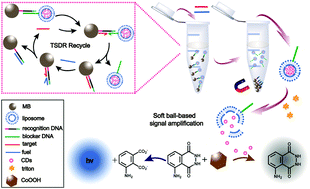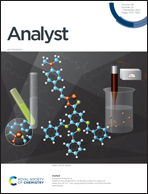Soft nanoball-encapsulated carbon dots for reactive oxygen species scavenging and the highly sensitive chemiluminescent assay of nucleic acid biomarkers†
Abstract
The expression level of nucleic acids is closely related to a variety of diseases. Herein, a highly sensitive detection of a nucleic acid based on a CoOOH-luminol chemiluminescence (CL) system without the addition of oxidants was proposed by the toehold-mediated strand displacement reaction (TSDR) and the liposome dual signal amplification strategy with the hybrid probe formed by linking soft nanoballs (SNBs) to magnetic beads (MBs) through DNA hybridization. Inspired by the free radical scavenging effect of the as-prepared carbon dots (CDs), CDs were successfully employed to quench the CL intensity of the CoOOH-luminol system. And the CDs were further encapsulated into liposomes to construct SNBs, which avoided the complex modification of CDs to maintain their original properties, as well as loaded a large number of CDs to scavenge free radicals to achieve signal amplification. Based on this, target DNA (tDNA) could be sensitively detected based on the reduced CL intensity, which achieved a dynamic detection range from 0.1 nM to 20 nM with a limit of detection as low as 59 pM (3σ/k), showing amazing promise in the biosensing of nucleic acid biomarkers.



 Please wait while we load your content...
Please wait while we load your content...